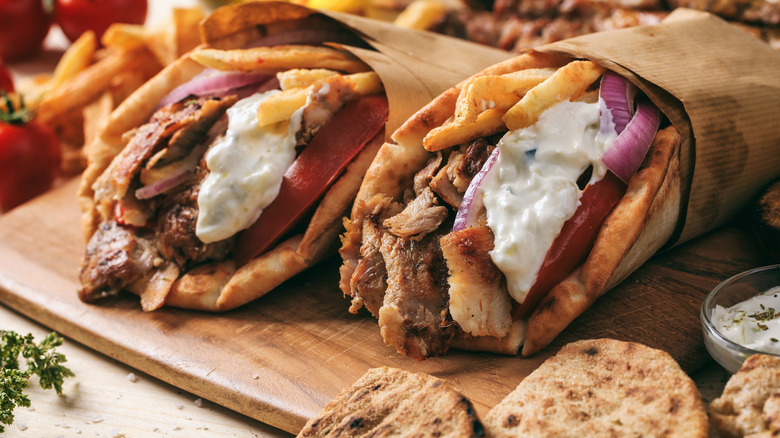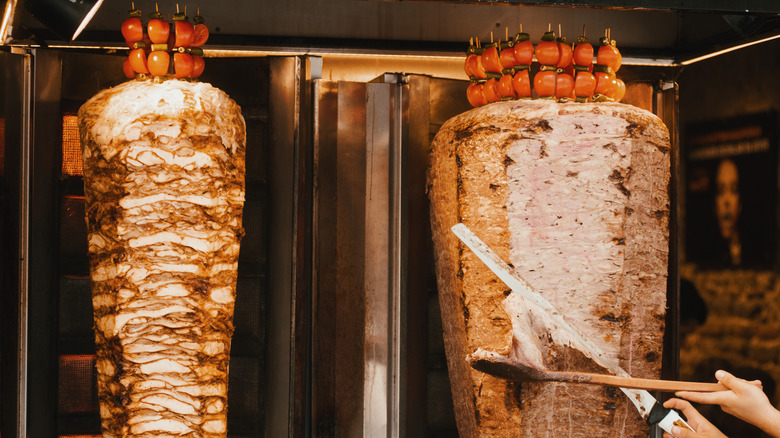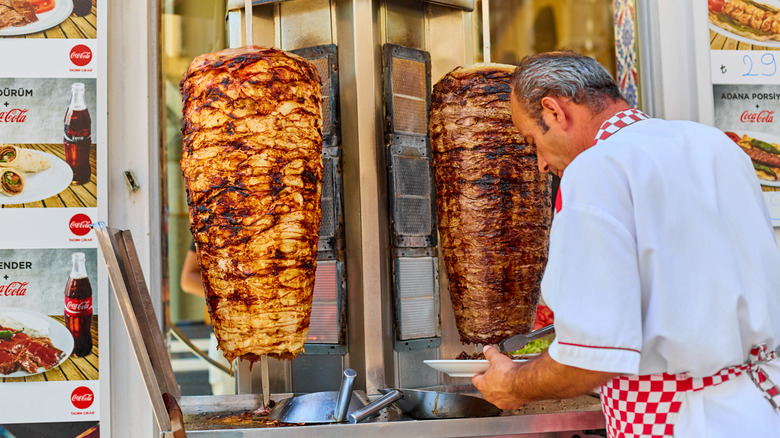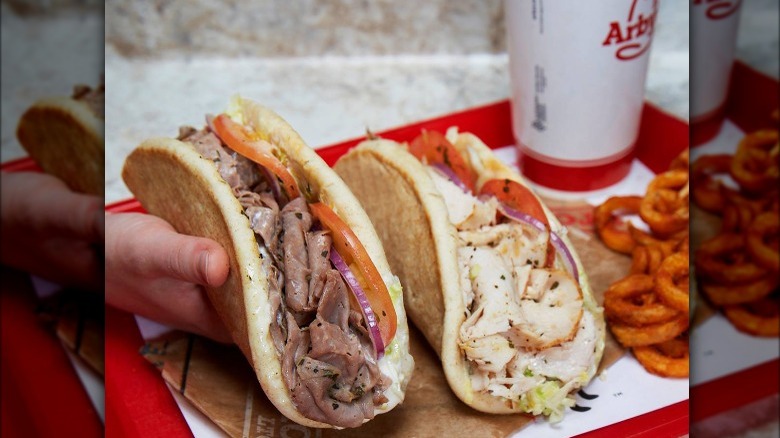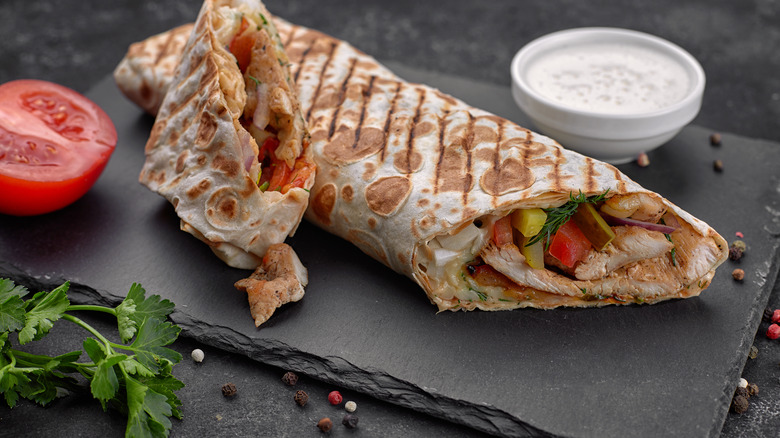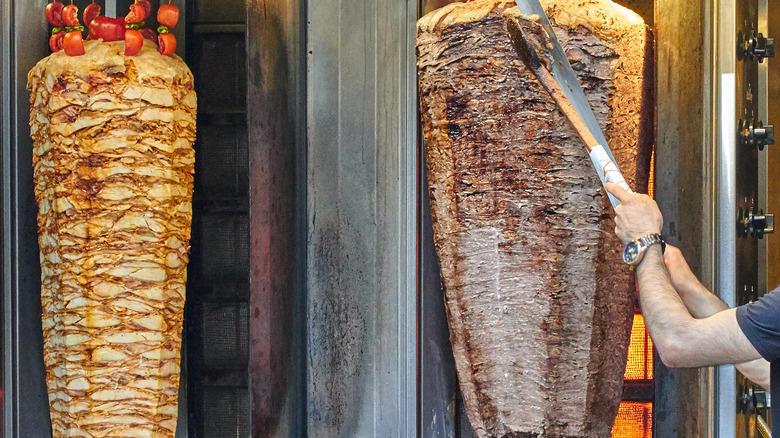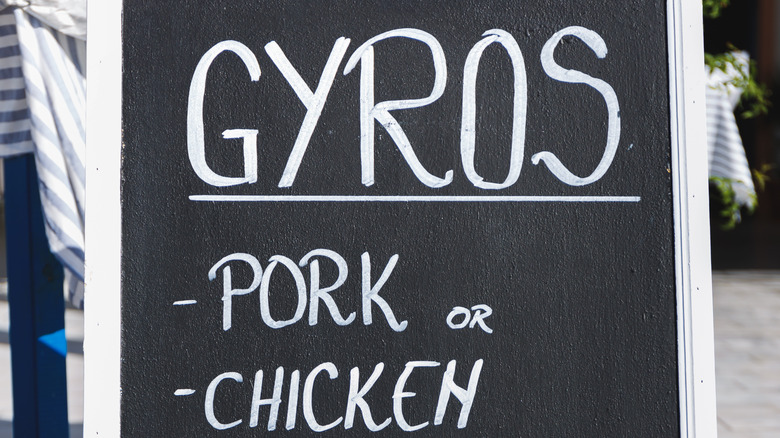The Untold Truth Of Gyros
Like many popular sandwiches, the gyro follows a standard: combine bread, meat, tomatoes, onions, lettuce, and a sauce. But in this case, the dressing and bread are special — a Greek sauce called tzatziki is made from dill and fresh yogurt and the entire package is served in a wrap of warm pita. Even with these inventive ingredients, what truly makes the gyro stand out is the recognizable preparation and cooking method of the signature protein. Gyro meat is traditionally cooked upright, piled high onto a rotating rotisserie spit. As the vertical skewer rotates, the "meat cone" is seared to a crisp on the outside, then thinly-sliced for each sandwich. It is an unmatched fusion of flavors and textures. Maybe not surprisingly, the gyro's origin is just as blended.
So the question spins on: Where did this hard-to-pronounce sandwich originally come from, and how did it get so popular with American eaters? The progression of the gyro reveals a story of history coming back to influence the present. From age-old methods of cooking to immigrant travelers striking it rich in new lands, there is more to know about this sandwich than its quick-to-eat qualities suggest. This is the untold truth of gyros.
The history of the gyro is hard to trace
Today, the gyro stands as an iconic food which represents Greek cuisine, but the real origin of the sandwich is not easy to pinpoint on a map. The New York Times reports that the gyro dates as far back as the early spit-roasted meats served in Persia to Alexander the Great's army. However, the upright rotisserie that defines modern gyro cooking first enters history far later than this, appearing sometime in the Ottoman Empire around the 1830s.
Priscilla Mary Isin, author of "Bountiful Empire: A History of Ottoman Cuisine" writes that the Ottomans first likely began using vertical spits to save space in compact food shops and markets. The dish that arose from these sizzling Turkish rotisseries are called döner kebabs. While döner kebab differs ingredients-wise from the modern gyro, the resemblances they share in cooking technique — meat roasted on an upright rotisserie — suggest that döners played an important part in helping the popular sandwich develop.
Still, despite the here-there-everywhere origin of how gyro meat is cooked, the dish does maintain strong ties to Greece. In the 1920s, Greek, Turkish, and Armenian immigrants from across Asia Minor helped to popularize the style of rotisserie cooking. Then, as the fast food movement of the 1950s roared on, immigrants again played a crucial part in helping the gyro develop into its current form as Greeks moved en masse to America. Nowadays, gyros are readily available all over the U.S. as well as Greek cities like Thessaloniki or Athens (via The Greek Food).
The World Wars helped gyros spread
When it comes to food, the World Wars are often regarded as times of sacrifice and rationing. Other than the scarcity of certain ingredients and foods, war years are also a period of food migration. When populations of refugees began fleeing ravaged lands across Europe, Asia, and Africa, one of the few things they could carry with them was the knowledge of food cultures. During World War I and World War II, the roots of the first gyro traveled with these migrants.
On the heels of the conclusion of World War I, Greece and Turkey engaged in conflict between 1919 and 1922. According to Origins, the Greco-Turkish War resulted in a forced population exchange between the two nations, with Turkish Muslims being compulsorily removed from Greece, and Greeks being driven back to their own country. According to travel company Corfu Perspectives, the ensuing "Asia Minor Catastrophe" resulted in a cultural exchange; immigrating Greeks merged with Eastern European populations of Armenians and Turks, moving across the continent and bringing the form of döner kebabs with them.
A decade after World War II, Greeks began to leave Europe in order to escape the economic hardship of the post-war years. Again, the gyro went with them. In 1965, the U.S. repealed certain restrictions on Greek immigrants, leading to a growth in the Greek-American population (via Encyclopedia of Chicago). The boom was especially large in cities like Chicago and New York. At the time, America was in the midst of a fast food revolution which the gyro would fit perfectly into.
The U.S. gyro explosion started in New York and Chicago
A New York slice. Chicago hot dogs. Readily available, inexpensive food is part of the fabric of eating in these two cities, both of which are key ingredients in the mixing pot that is American eating. In the 1970s, a quick-foods revolution was running through the U.S. As the Times details, New York vendors were taking to the street with new flavors and curbside techniques, using upright gyro rotisseries to save space within their food carts just like generations before them had. The easy-to-handle sandwich offered something fresh, hot, and inexpensive.
Meanwhile, a full-scale gyro industry was developing in Chicago. Greek immigrants were joining the Midwest's food industry in large numbers, opening comfortable restaurants for fellow citizens. As the Chicago Tribune notes, many of them sold American foods in their shops and ate Greek food at home. That is until a day in 1965, when a man named George Apostolou claims he began selling the first gyros in America at his Parkview Restaurant in Chicago. By the time New Yorkers started slinging street-side gyros at Olympic speeds, industry-minded Chicagoans were already imagining how to mass produce the meat stacks for a hungry market.
The gyro is a dish that has a long reputation of appearing in multiple places at once, so it's spontaneous arrival in Chicago and NYC is part of the recipe. The American appetite for gyros has grown since the '70s, outpacing the mom-and-pop production in a more Americanized industrial model.
Pre-seasoned gyro cones are an industry
A later history of gyros from The New York Times details that shortly after gyro vendors started emerging on New York street corners, industrialized gyro cone makers began moving into Chicago's meatpacking industry to greet their needs. Up until the late '70s, people who were serving gyros were mostly making the characteristic meat cones one by one, from passed-down family recipes and within their own kitchens. Not very efficient. With the spirit of McDonald's expansion across the continent, businesses like Kronos of Chicago, Gyro Inc., and Olympia Foods began to develop pre-stacked, flash frozen, ready-to-cook cones that could be shipped nationwide.
These cones are made from a mix of meat trimmings — sometimes beef and lamb, occasionally pork. The meats are ground together, seasoned with breadcrumbs and spices, then compacted under intense hydraulic pressure. The result is something the Times refers to as a meat "Popsicle." They may not look appetizing when flash frozen, but if you've ever eaten a gyro from a chain restaurant, then it's likely you've enjoyed these pre-fab cones in their tastiest form.
Despite George Apostolou's claim to also have started the first mass-produced gyro line, Peter Parthenis of Chicago maintains that his pre-made cones were the earliest on the scene — so early, that he would actually deliver them to customers by Greyhound bus. The legacy of who started the modern gyro industry is contested, but the success of the business is far from being questioned.
Americans eat an amazing amount of gyros every year
While the gyro is an internationally known food with a global history, there are few places where the sandwich is as craved as it is in America. Among the thousands of lunch carts, restaurants, and fast food giants that are selling gyros, there is no doubt that the U.S. has a massive appetite for the sandwich.
When it comes to the fast food industry, Business Wire reports that Arby's sells 27 million gyros a year when you combine the several options available on the menu. Arby's gyros meat is sourced right off of spit roast rotisseries, which benefits gyro makers like the previously mentioned Kronos Inc. Back in 2012, then Kronos CEO Michael Austin claimed that over 100 million gyros sourced from his company were consumed annually in the United States (via Fox News). That's a big chunk of meat. The gyro has become so popular that foodies even celebrate National Gyro Day on September 1.
Not surprisingly, the taste for new and different flavors from the Mediterranean and Asia Minor has traveled alongside the gyro. These days, finding dishes inspired by or complementary to the gyro is fairly easy.
Gyros have distinct differences from shawarma
As a descendent of the döner kebab, the gyro gets its character from the rich tradition of spit roasted cooking, but it isn't the only food with this birthright. Döner has provided an identity for many styles of food that developed in the space between Europe and Asia. Shawarma is a good example. While the Middle Eastern dish is a close cousin of the gyro, there are distinct differences between a gyro and shawarma.
Both sandwiches derive their identity from specially skewered and seasoned meat hunks that are cooked and sliced in particular ways. Yet, their source of meat is often different: In Greece, gyros are made mostly of pork; in America it is a blend of lamb and beef. Meanwhile, the Middle Eastern shawarma is chicken, beef, and even fish, but never pork due to religious dietary restrictions. Both sandwiches are served in pita and piled with toppings, but even these aren't the same for both. Shawarma is also heavily seasoned by regional spices like sumac and za'atar.
While many shawarma chefs use a standing rotisserie, the dish can (and often is) cooked horizontally. Horizontal cooking may occasionally be used in Greek-American restaurants (or certain fast food joints), but a proper gyro comes thinly sliced straight from the cone. In spite of the similarities between dishes like shawarma, the gyro maintains a distinct personality.
From humble Ottoman origins, the döner kebab has helped to inspire dishes like shawarma, gyro, and even tacos al pastor, though each has similarities with and differences from their culinary relatives.
Gyro is closely related to souvlaki
Another popular Greek food is the souvlaki. It is a dish that shares traits with the gyro and is often served up in places where the sandwich is found. Unfortunately, just like gyros, souvlaki has its own cases of mistaken identity. This distinctly Greek dish is often confused with the standard kebab.
Souvlaki is similar to a kebab in that it's skewered and grilled horizontally, but souvlaki meat is often pork while traditional kebabs are anything but. Souvlaki shares a similar marinade, seasoning, and flavor with gyros, but since the defining part of the pita-wrapped sandwich is the upright grilling, you may wonder how exactly the two are actually related. It's a classic question of which came first: the gyro or the souvlaki?
The modern gyro became popular in Greece in the 1920s, then America in the '70s. Yet as Corfu Perspectives details, ancient Greeks like Aristotle were consuming souvlaki centuries before the first rotisseries began turning out gyro meat. Then, World War II essentially erased the availability of the meat cuts needed to make souvlaki while the scraps characteristic for making gyros hung around. The two foods swapped places in popularity for decades. Eventually, the American hunger for gyros evolved into cravings for other, new Greek foods. This encouraged the rebirth of souvlaki. Now, the two can be found as part of a full Greek meal.
Greeks eat gyro differently
Americans may eat an incredible amount of gyros per year, but no matter how many pounds of them go down the hatch, this food still belongs to the native and immigrant Greeks who shared it with the world. That claim comes with some privileges, including the right to dress up the gyro with a variety of condiments and full-on ingredient combinations.
In America, the classic gyro is served like this: Toasted pita is filled with thinly sliced lamb, beef, or both. It is then topped with lettuce, tomato, red onions, and tzatziki sauce. The tangy toppings accent the spices of the meat and the entire thing leaves you with a flavor-packed bite of the Mediterranean. Yet, this isn't actually the common standard across the ocean. For starters, lamb gyros are rare in Greece — most native ones are made from pork (via The New York Times).
Expat blogger Home in Greece writes that the sandwich is also topped differently by native Greeks. Eaters in the north of the country often substitute ketchup and mustard for the tzatziki. Additionally, Grecians regularly stuff the pita with french fries in order to make an all-in-one meal. Just when you didn't think eating a gyro could be any more convenient Greek cooks reinvent the game.
The upright rotisserie is crucial for authentic gyros
With the right seasoning, spicing, and marinating recipes it is entirely possible to make something that tastes like a gyro at home. Purchase some quality meat, cook in a cast iron or on the grill, whip up a tasty tzatziki, and stuff your pita. But if you've had the pleasure of eating gyro meat off of a spit you'll be able to recognize the difference in the all-important texture of the meat. If you are dreaming of eating the crispy edges and juicy fillings of an authentic gyro sandwich, then you should know just how crucial the upright rotisserie actually is.
The Barbecue Bible details why: Thanks to gravity, the upright stack of meat bastes each lower layer below it with the fat and juice of the strip above, all throughout the cooking process. This action is what develops the crusty edges that define gyro meat texture. It is also what makes the inside layers moist and flavorful. For the best outcome, the upright rotisserie is furnaced by coal instead of convection heaters in order to develop a true char.
Again, it is possible to make great-tasting gyros at home. But if you are an eater who is big on texture and authenticity then you should visit your neighborhood gyro specialist (and soon).
Pronunciation is an important part of gyro culture
Is it "yee-roh," or "jeer-oh?" You may have also heard it said as "hee-roh," "gear-oh," or "guy-roh" too. When someone suggests ordering Greek food, the pronunciation of this sandwich always ends up as a low-hanging fruit for the jokers in the group (we see you, Jimmy Fallon). Despite that, the name's etymology is serious business. In fact, the root of the word has a link to the direct nature of the gyro.
The Online Etymology Dictionary notes that the word gyro comes from the Greek word gyros which means "to spin," as well as the word gheereezo, which means to turn (via TasteAtlas). Since gyros are a recreation of the rotating Turkish döner kebab, it is clear that the Greek name for the dish literally comes from the movement of the rotisserie. In America, we might've called it a "spin" sandwich. (Thankfully, it sounds much cooler in Greek.) Due to its tricky pronunciation, gyro sandwiches are sometimes mistaken for the Italian-style hero sandwich when spoken about, but the two are not similar. The hero is closer to a traditional hoagie, po'boy, or sub.
No matter how you choose to say the word, the outcome of ordering one will be the same: A gyro is sure to leave you with a mouthful of amazing, other-worldly food. The next time you eat a warm bundle of pita and spit roasted meats, consider how far the tradition was carried in order to make it to your plate. A sandwich by any other name still tastes as savory.
